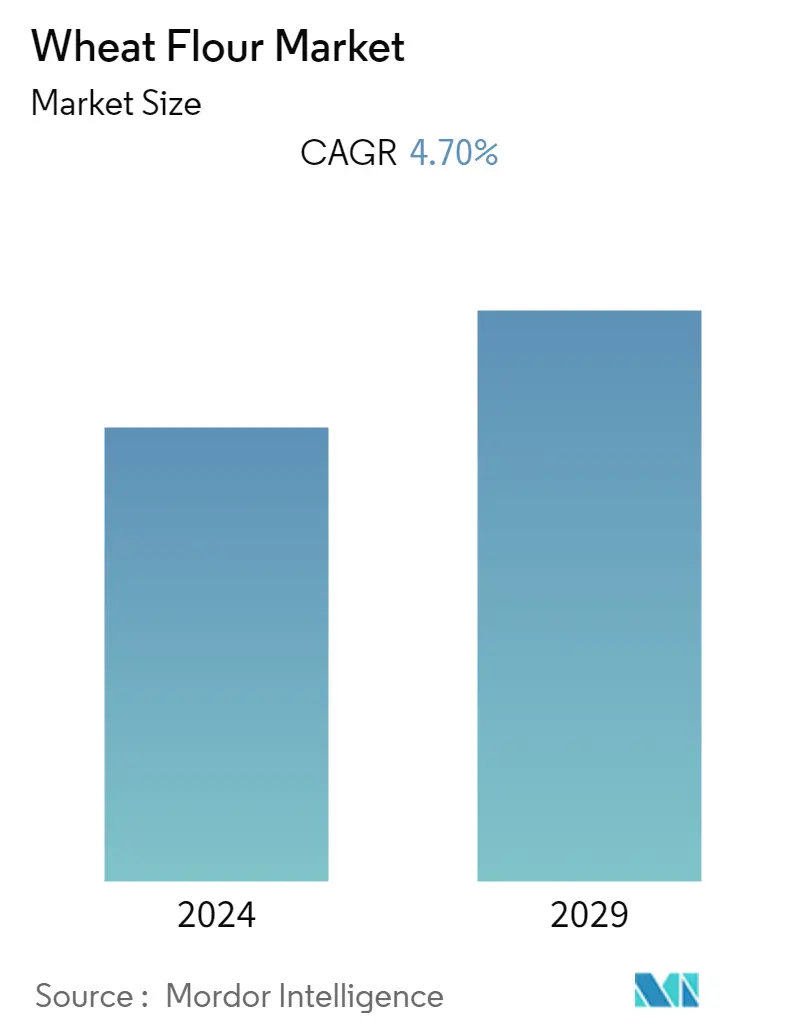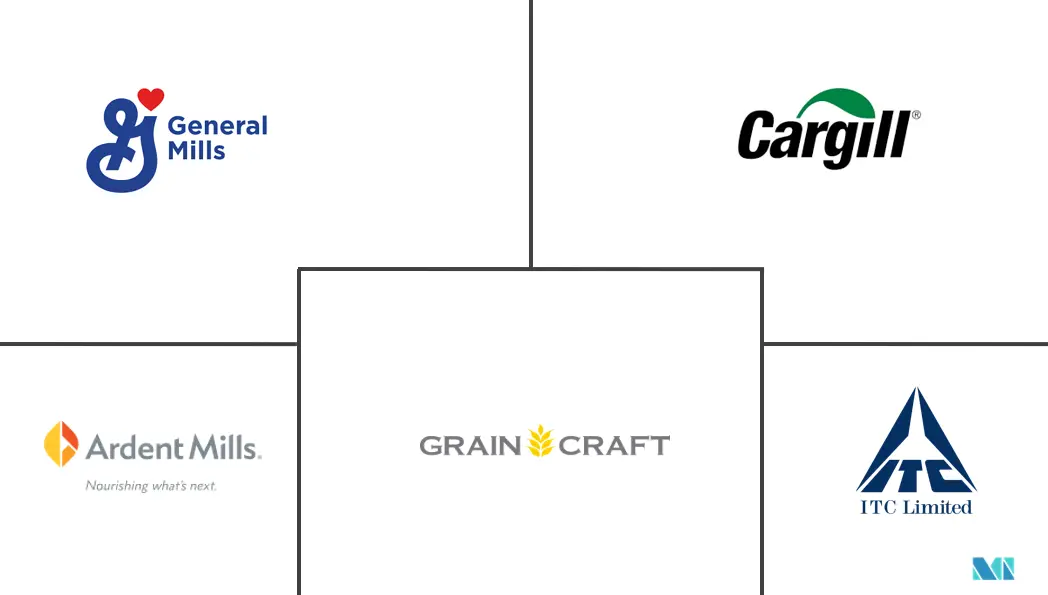Market Size of Wheat Flour Industry

| Study Period | 2019 - 2029 |
| Base Year For Estimation | 2023 |
| CAGR | 4.70 % |
| Fastest Growing Market | Europe |
| Largest Market | Asia-Pacific |
| Market Concentration | Low |
Major Players
*Disclaimer: Major Players sorted in no particular order |
Wheat Flour Market Analysis
The wheat flour market is projected to register a CAGR of 4.7% during the forecast period, 2022-2027.
The rising popularity of processed foods among worldwide consumers is driving market growth as wheat flour is one of the key ingredients used in many convenience foods, including bakery products such as bread, snacks such as biscuits, waffles, and ready-to-eat meals. Due to the expanding food industry and better economic situations, consumers in both developed and emerging nations are more likely to favor ready-to-eat packed meals.
Moreover, wheat flour is used extensively owing to the presence of gluten, a protein that provides strength and elasticity to the dough as well as adds to the texture of baked products. The flour enhances the food product's texture and flavor characteristics. Therefore, the popularity of instant foods such as instant noodles, and ready-to-cook tortillas among others are driving the growth of the wheat flour market. Additionally, the high demand for clean-label food ingredients due to the increased health consciousness among consumers is driving the demand for different variants in wheat flour such as gluten-free wheat flour, organic wheat flour, and fortified wheat flour globally.
Wheat Flour Industry Segmentation
Wheat flour is made by grinding or milling the wheat grain and contains all the constituents of the wheat kernels. The global wheat market (henceforth referred to as the market studied) is segmented by type, category, distribution channel, and geography. By type, the market is segmented into whole wheat flour, all-purpose flour, and others. By category, the market is segmented into organic and conventional. By end user, the market is segmented into hotels, restaurants, catering (HoReCa); retail; and industrial manufacturing. Retail is further sub-segmented into supermarkets/hypermarkets, convenience stores, online stores, and other distribution channels. It provides an analysis of emerging and established economies across the world, comprising North America, Europe, South America, Asia-Pacific, and Middle-East and Africa. For each segment, the market sizing and forecasts have been done on the basis of value (in USD million).
| By Type | |
| Whole Wheat Flour | |
| All-Purpose Flour | |
| Others |
| By Category | |
| Organic Wheat Flour | |
| Conventional Wheat Flour |
| By End User | ||||||
| Hotel, Restaurants, and Catering (HoReCa) | ||||||
| ||||||
| Industrial Manufacturing |
| Geography | |||||||||
| |||||||||
| |||||||||
| |||||||||
| |||||||||
|
Wheat Flour Market Size Summary
The wheat flour market is experiencing significant growth, driven by the increasing demand for processed and convenience foods globally. Wheat flour is a fundamental ingredient in various bakery products and ready-to-eat meals, making it a staple in the expanding food industry. The flour's gluten content provides essential strength and elasticity to dough, enhancing the texture and flavor of baked goods. This has led to a surge in the popularity of instant foods and ready-to-cook products, further propelling market expansion. Additionally, the rising health consciousness among consumers is boosting the demand for clean-label food ingredients, including gluten-free, organic, and fortified wheat flour variants. The shift towards organic foods, perceived as more nutritious and environmentally friendly, is particularly notable, with manufacturers responding by offering diverse packaging options to cater to retail markets.
The Asia-Pacific region is a major consumer of wheat flour, with its use in staple foods and the growing number of eateries and food service operators contributing to increased demand. The region's shift from rice to wheat-based products, driven by nutritional preferences and the adoption of Western foods, is further fueling market growth. The wheat flour market is highly fragmented, with numerous organized and unorganized players, including major companies like General Mills, ITC Limited, and Archer Daniels Midland Company. These key players are actively expanding their geographical presence through mergers, acquisitions, and enhanced distribution capabilities. The entry of new food processing companies into the market, such as Parle Products and Gujarat Co-operative Milk Marketing Federation Limited, highlights the emerging business opportunities in the sector.
Wheat Flour Market Size - Table of Contents
-
1. MARKET DYNAMICS
-
1.1 Market Drivers
-
1.2 Market Restraints
-
1.3 Porter's Five Force Analysis
-
1.3.1 Threat of New Entrants
-
1.3.2 Bargaining Power of Buyers/Consumers
-
1.3.3 Bargaining Power of Suppliers
-
1.3.4 Threat of Substitute Products
-
1.3.5 Intensity of Competitive Rivalry
-
-
-
2. MARKET SEGMENTATION
-
2.1 By Type
-
2.1.1 Whole Wheat Flour
-
2.1.2 All-Purpose Flour
-
2.1.3 Others
-
-
2.2 By Category
-
2.2.1 Organic Wheat Flour
-
2.2.2 Conventional Wheat Flour
-
-
2.3 By End User
-
2.3.1 Hotel, Restaurants, and Catering (HoReCa)
-
2.3.2 Retail
-
2.3.2.1 Supermarket/Hypermarket
-
2.3.2.2 Convenience Stores
-
2.3.2.3 Online Retail Stores
-
2.3.2.4 Other Distribution Channels
-
-
2.3.3 Industrial Manufacturing
-
-
2.4 Geography
-
2.4.1 North America
-
2.4.1.1 United States
-
2.4.1.2 Canada
-
2.4.1.3 Mexico
-
2.4.1.4 Rest of North America
-
-
2.4.2 Europe
-
2.4.2.1 Germany
-
2.4.2.2 United Kingdom
-
2.4.2.3 France
-
2.4.2.4 Spain
-
2.4.2.5 Russia
-
2.4.2.6 Italy
-
2.4.2.7 Rest of Europe
-
-
2.4.3 Asia-Pacific
-
2.4.3.1 China
-
2.4.3.2 India
-
2.4.3.3 Japan
-
2.4.3.4 Australia
-
2.4.3.5 Rest of Asia-Pacific
-
-
2.4.4 South America
-
2.4.4.1 Brazil
-
2.4.4.2 Argentina
-
2.4.4.3 Rest of South America
-
-
2.4.5 Middle East & Africa
-
2.4.5.1 Saudi Arabia
-
2.4.5.2 United Arab Emirates
-
2.4.5.3 South Africa
-
2.4.5.4 Rest of Middle East & Africa
-
-
-
Wheat Flour Market Size FAQs
What is the current Wheat Flour Market size?
The Wheat Flour Market is projected to register a CAGR of 4.70% during the forecast period (2024-2029)
Who are the key players in Wheat Flour Market?
ITC Limited, General Mills Inc, Cargill Incorporated, Ardent Mills LLC and Grain Craft are the major companies operating in the Wheat Flour Market.

